
Become a member
Join today and help protect nature, beauty and history – for everyone, for ever. Enjoy access to more than 500 places with National Trust membership.
Lord and Lady Bearsted’s 1930s country retreat with dramatic terraced gardens and world-renowned art collection.
near Banbury, Warwickshire, OX15 6HT

| Asset | Opening time |
|---|---|
| Garden | 11:00 - 16:00 |
| House | 11:30 - 15:30 |
| Restaurant | 11:00 - 16:00 |
| Shop | 11:00 - 16:00 |
During the quieter winter months, we take the opportunity to carry out conservation work in the house. To give you more opportunities to visit and discover the collection, the house will remain open daily, some days will be free flow, others will be via guided visits.
From 7 January, on Tuesdays, Wednesdays and Thursdays guided views will run every half hour, between 11.30am and 2.30pm. No booking in advance is required, the time slots will be issued on a first come, first served basis at Visitor Reception upon arrival. The guided view will include light touch information about the house and collection, (please note, this is not a full tour.)
On Mondays, Fridays and the weekends, the house will be open free flow between 11.30am - 3.30pm (last entry 3pm, there is a 5-10 minute walk between the car park and the house).
On busy days, we may operate timed tickets for house entrance and these will be subject to availability.
As it isn't possible to have all items or rooms on permanent display, please contact us before you visit if there is a particular collection item or room you are visiting to see.
The gardens are open via the winter walk, which follows the hard paths around the perimeter of the garden.
| Ticket type | With Gift Aid | Without Gift Aid |
|---|---|---|
| Adult (18+) | £18.70 | £17.00 |
| Child (5-17) under 5s free | £9.40 | £8.50 |
| Family (2 Adults and up to 3 children) | £46.80 | £42.50 |
| Family one adult | £28.10 | £25.50 |
| Group (Adult 18+) | £16.15 | |
| Group (Child 5-17) | £8.08 |
| Ticket type | With Gift Aid | Without Gift Aid |
|---|---|---|
| Adult (18+) | £19.80 | £18.00 |
| Child (5-17) under 5s free | £9.90 | £9.00 |
| Family (2 Adults and up to 3 children) | £49.50 | £45.00 |
| Family one adult | £29.70 | £27.00 |
| Group (Adult 18+) | £17.10 | |
| Group (Child 5-17) | £8.55 |
We welcome assistance dogs in all areas of the property if they are wearing their tabards/harness and working. Please ask your dog to toilet before entering the property. A tap is available in the plant centre if you need to refill a water container for your dog. Please ask if you require assistance. There are several sheer drops and steep steps.
There is a 1 hour tour available on the Smartify app, free to download.
Located adjacent to the Squash Court Gallery. There is stepped access.
The Pavilion Café is open for light lunches, snacks and a range of hot and cold drinks.
300 yards from the House, Pavilion Cafe and Shop along a level path.
Cycle parking is adjacent to the Visitor Reception building. There is a small repair kit available upon request at reception.
Children under 5 on scooters, balance bikes and bikes with stabilisers are allowed under close supervision except in the formal gardens and in the Quiet Orchard. Baby-changing and feeding facilities available. There are several sheer drops, steep steps and areas of open water.
You can picnic on the South Lawn or Sunken Garden, please bring your own rugs or small folding chairs. There are a few picnic tables in the courtyard outside the Shop and on the grassy areas on the edge of the overflow car park. We ask you not to picnic on the tables outside the Pavilion Cafe.
Come and take a look around Upton's gift shop, where you'll find a great range of products for every occasion. We urge all visitors to bring minimal items with them into the house including no large bags. Large bags, rucksacks and pushchairs can be left in the white summerhouse next to the shop.
Toilets including accessible toilets are situated in the courtyard by the shop and in the Pavilion Café. There are no visitor toilet facilities in the House.
The House, Pavilion Café and Shop are 300m from the car park. The garden is partially accessible to visitors with mobility impairments. There is a ramped entry at the main garden entrance. There is also access via sloping paths through the orchard opposite the café. Beyond the south lawn, the gardens descend steeply in a series of terraces, the routes are via stone staircases or steep grass and crushed stone pathways. There are unguarded ponds, slopes and drops throughout the garden. There is designated ‘disabled’ parking available, we offer a volunteer operated driver-assisted buggy, an accessible toilet, an accessible wheelchair route through the ground floor of the house and through parts of garden. Please note – we are not able to accommodate pushchairs or large bags in the main house; they can be stored in the summer house adjacent to the shop. We do have hip carriers available to borrow (subject to availability). Please ask at Visitor Reception or upon entrance to the main house for more information
The admission leaflet contains a map detailing surfaces and locations of steps and sheer drops. The garden has a level section behind the House and the South Lawn, then descends steeply in a series of terraces, accessed via a mixture of natural grass, woodland and loose stone pathways and stone steps.
Accessible route and/or map - more informationAccessible toilets are available in the courtyard by the Shop and in the Pavilion Café. Left-hand transfer and lit by a fluorescent bulb. Paper towels available for hand drying.
Braille guides available that include an introduction to Upton House and Gardens and its collections. These are available upon request at the entrance to the house. All our written interpretation is in large print.
There are 7 designated parking bays for disabled visitors in the main car park, 300 yards from the House and shuttle service is available. There are 3 parking bays for disabled visitors close to the House. Visitors may also drop off disabled passengers at the House before returning to the main car park. Please enquire at Visitor Reception for assistance.
Visitors may drop off disabled visitors close to the house before returning to the main car park. Our welcome team will be happy to facilitate this on the day. You are also welcome to contact us ahead of your visit if you would like to discuss any arrangements to help plan your visit.
Hearing loops are available in Visitor Reception, Shop and Pavilion Cafe. Portable induction hearing loops are also available to visitors attending talks in the house.
All our written interpretation is in large print.
There is level access to the Pavilion Café, part of which is sloped, so you may require assistance.
Entrance via the Courtyard Plant Centre, The courtyard has a level bonded gravel surface.
We are located on the edge of an ice age valley and there are several sheer drops. Most of the garden access is via steep steps and slopes, but can be seen from the edge of the South Lawn which overlooks a 30m drop to the Mirror Pool below. The open rooms on the ground floor are fully accessible.
There are Highlight folders detailing the collection items on display on the Lower Ground Floor available to view in the Entrance Hall or the West landing area on the Ground Floor.
There is a ramped side access to the House. If you require assistance please ask at the main entrance to the House where the team will facilitate access..
There is seating in the Courtyard outside the shop and there is some seating available in the gardens. but you are welcome to bring along a small fold-up chair or rug. Visitor seating is available in every room of the house; please ask any of our house hosts for assistance.
The lower terraces of the garden include steps and uneven terrain.
There is a covered golf buggy available between reception and the House, Shop and Pavilion Cafe. This is a volunteer run service; on days when volunteer drivers are unavailable, please ask the welcome team at reception for alternative arrangements.
We have outdoor and indoor wheelchairs available for you to borrow. Please ask our welcome team if you would like a wheelchair; they can also arrange for one to be ready for you at the main house entrance, or at the ramped side entrance. You can contact us in advance to reserve a wheelchair.
Upton House sits on top of Edgehill on the A422 between Banbury and Stratford upon Avon and has stunning views over the surrounding countryside.
Banbury train station approximately 8.5 miles
Stratford upon Avon train station approximately 13.7 miles
Oxfordshire Cycle Way 1½ miles.Plan your route to Upton House and Gardens using the CycleStreets journey planner via the bicycle link below. (This journey planner uses OpenStreetMap data which is generally excellent but accuracy cannot be guaranteed. If you come across a footpath or other cycle-prohibited track, please don't ride on it.
Usual admission prices apply
Bring your group to visit Upton House and Gardens, see the famous art collection, enjoy the beautiful gardens or hear stories of Upton's history as a home.
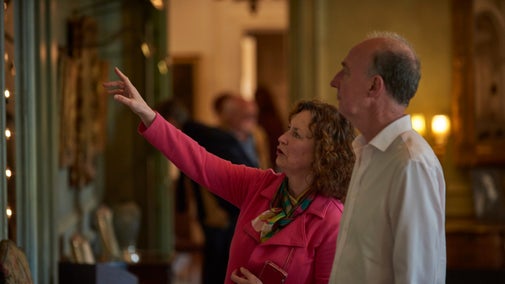
Take a look at the map of Upton House and Gardens to help plan your visit
Here you'll find information about access across the different areas of Upton House and Gardens and how to make the most of your visit.
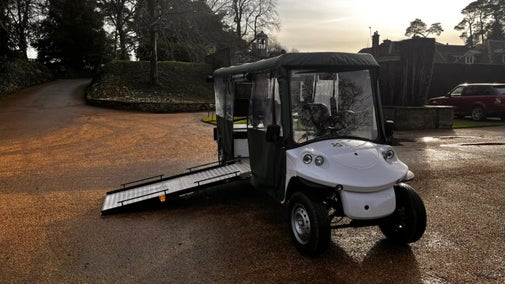
Honey-coloured country house, remodelled for Lord and Lady Bearsted’s 1930s country retreat. Houses a world-renowned art collection and fine Chelsea porcelain.
Dramatic terraced gardens designed by Kathleen Lloyd Jones during the 1930s with herbaceous borders, orchard, mirror pool and woodland walk.
The Pavilion Café serves a range of hot and cold light lunches, snacks, and drinks with indoor and outdoor seating.
Gift shop and plant centre with a selection of unique gifts and seasonal gardening ranges and second-hand bookshop.
See all we have going on over late winter into early spring.
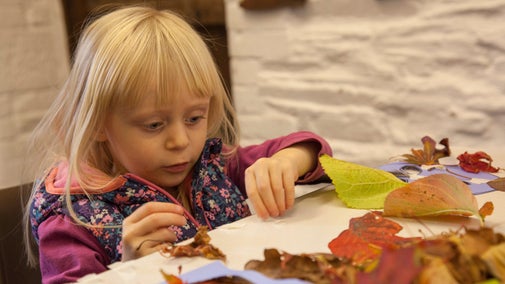
Find out what's on for families at Upton House and Gardens, spot wildlife on the Woodland Walk or simply let off steam in acres of space outdoors. If you're planning for spring, find out more about all we have coming up.

Delve deeper into the treasured collection at Upton House using the new Smartify app.
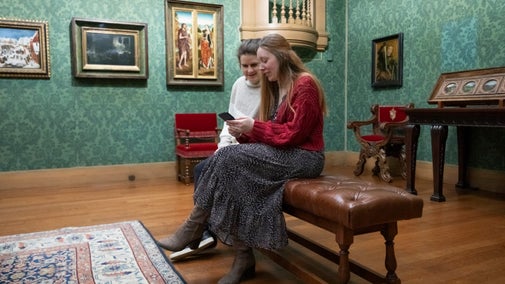
Immerse yourself in one of the finest art collections in 20th-century England, which was the country house and weekend retreat of 2nd Viscount Bearsted, Walter Samuel.

Visit Upton's historic garden and marvel at the view that unfolds in front of you. Discover the Mirror Pool and views from the south lawn.
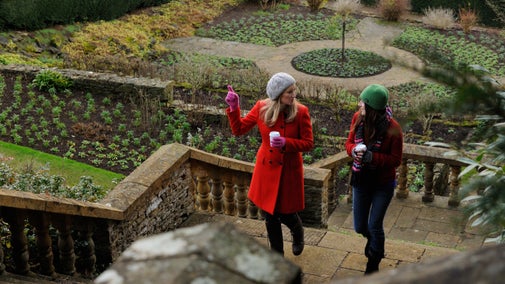
We’re one of the places featured in series three of BBC Two's Hidden Treasures of the National Trust. The show goes behind the scenes to hear from the experts who look after treasured objects, including the painting 'The Wise and Foolish Virgins' by Tintoretto in episode 5. Watch the series on BBC iPlayer.
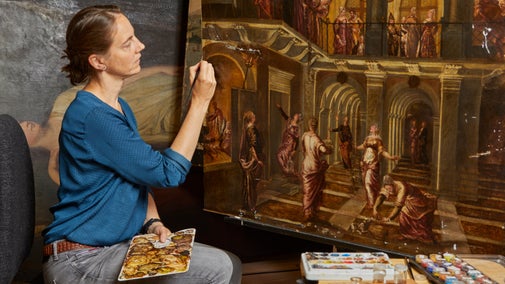
Stop by the Pavilion Café on your visit to Upton House and grab a bite to eat, a hot or cold drink and a slice of cake. Buy a souvenir of your visit in the shop, or pop into the second-hand bookshop for a new read.
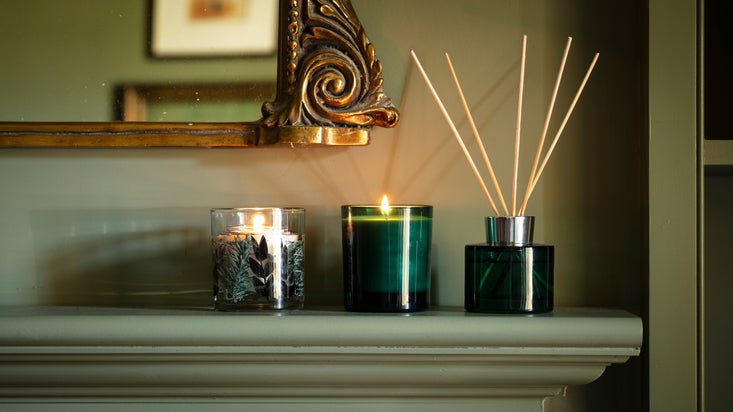
Amble through arable land for spectacular views across Warwickshire and down to the site of the historic first battle of the English Civil War.

Trace the ley lines first discovered by an amateur archaeologist in 1921 in this history-packed circular trail from Upton House.

Arable ambling in Warwickshire's countryside, with the opportunity to stop off at a village pub along the way.


On the grounds of Upton House, overlooking the bog garden, this former banqueting house is a stylish retreat.

With its own private garden, this former stable on the Upton estate has an Art Deco-inspired interior.
Use all your senses in Upton's outdoors this winter season with this slow-looking resource for little explorers.
Celebrating the nine Greek Muses in our collection, Upton House and Gardens presents ‘Modern Muse’, an exhibition by acclaimed photographic artist Arpita Shah.
Join photographic artist Arpita Shah at Upton House and Gardens to discuss the making of her acclaimed series Modern Muse, which opens for display today.
‘The Six Seasons’ is an exhibition of new digital collages by the British artist Emily Allchurch inspired by Bruegel’s ‘Seasons’ paintings from 1565.
Discover the Warwickshire countryside surrounding Upton House and Gardens and meet new people on these gentle-to-moderate walks.
Lizzie Bentley leads this fun drawing class amidst the galleries at Upton House and inspired by its world-class collection of European art.
Join Debbie Wild from the Swan School of Tai Chi and Qigong to discover this ancient Chinese exercise in these weekly classes suitable for beginners and all levels of fitness.
Discover more about the history of Upton House and how following its acquisition by Lord and Lady Bearsted in 1927, they set about improving the estate and hiring garden designer Kitty Lloyd-Jones to improve the garden.

Take a look at some of the conservation work that takes place at Upton to look after this place for everyone, for ever.

Discover how a rare painting by Venetian artist Jacopo Tintoretto has been researched, and conserved in a detailed project.
Explore the objects and works of art we care for at Upton House on the National Trust Collections website.

Interested in volunteering with the National Trust at Upton House and Gardens? Discover how to get involved, as well as the benefits of joining our team of over 200 volunteers. Upton’s volunteers are involved in all aspects of the property and help to make sure that our visitors have the best experience possible.


Join today and help protect nature, beauty and history – for everyone, for ever. Enjoy access to more than 500 places with National Trust membership.
By sharing your email address you’re agreeing to receive marketing emails from the National Trust and confirm you’re 18 years old or over. Please see our for more information on how we look after your personal data.